It's been two years since I've updated the website. As I mentioned in the last post, I started medical school in August 2015. Since that time, my life has been dominated (by choice, mostly) by the Krebs cycle, selective serotonin reuptake inhibitors, standardized patients, computed tomography images, treatment algorithms, and, in the past four months, real patients in need of real care. It's been quite an adventure, and although I sometimes pine for the relatively simpler days of taking and submitting pictures, I don't regret exchanging one thrilling career for another.
This month, I'm taking an advocacy elective, and its seminar format affords a lot more free time than my first two clerkships of surgery and psychiatry. So, I finally have time to post an update to this six-year-old blog. It's not the post that I promised two years ago ("a catch-up catch-all entry ... before school completely dominates my life"); that post will come next. First, I want to post some pictures from the thing that completely dominated my life (mostly; I had some free time). Most of these pictures are of concepts I drew for study purposes, but there is a bonus collection of images from the solar eclipse this year. Explanations for each concept appear in the captions.
Welcome back!
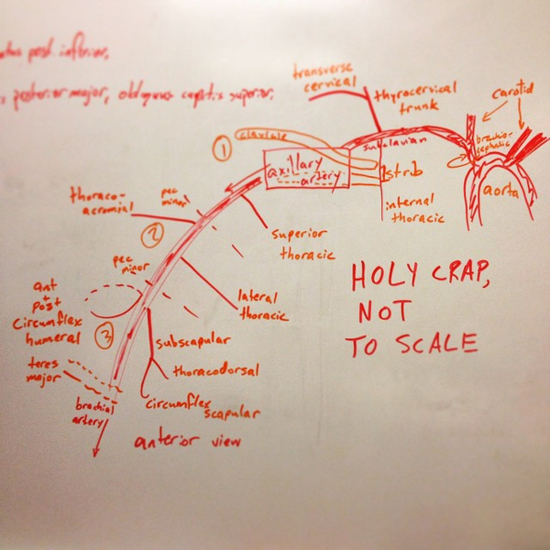 Poorly proportioned picture representation (with alliteration!) of arteries of the right arm. This is one of my first drawings in medical school, and anatomy class (for which I used this to study) would begin my long, slow dive into my habit of drawing pictures on whiteboards and blank paper. I wasn't the only one; drawings of brachial plexuses and biochemical pathways festooned every whiteboard in the medical school hallway, drawn by many different hands.
Alex Farris
Poorly proportioned picture representation (with alliteration!) of arteries of the right arm. This is one of my first drawings in medical school, and anatomy class (for which I used this to study) would begin my long, slow dive into my habit of drawing pictures on whiteboards and blank paper. I wasn't the only one; drawings of brachial plexuses and biochemical pathways festooned every whiteboard in the medical school hallway, drawn by many different hands.
Alex Farris
 The Krebs cycle. Speaking of biochemical pathways, this is, uh, one of them. It describes the movement of electrons from acetyl-CoA (the molecule at the top of the picture) onto the electron carriers NADH and FADH2. These electrons are brought to a cascade of falling energy that is used to build up a gradient of protons in a cell's mitochondria. I know this is probably hard to follow, but this big circle of reactions is an important conduit for many processes in a cell, from energy production to the making of new sugar molecules to the breakdown of proteins.
Alex Farris
The Krebs cycle. Speaking of biochemical pathways, this is, uh, one of them. It describes the movement of electrons from acetyl-CoA (the molecule at the top of the picture) onto the electron carriers NADH and FADH2. These electrons are brought to a cascade of falling energy that is used to build up a gradient of protons in a cell's mitochondria. I know this is probably hard to follow, but this big circle of reactions is an important conduit for many processes in a cell, from energy production to the making of new sugar molecules to the breakdown of proteins.
Alex Farris
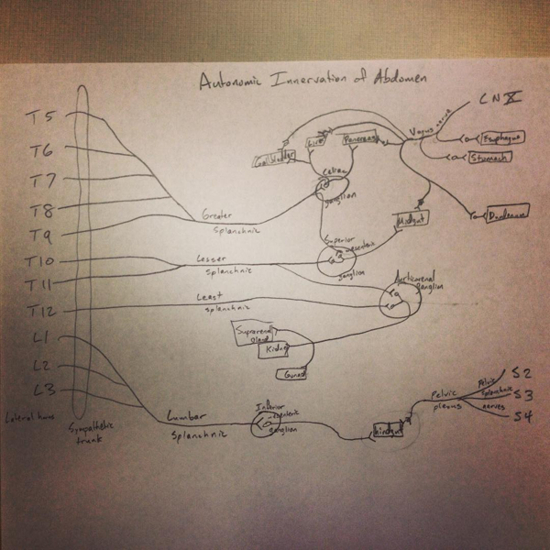 Autonomic innervation of the abdomen. On the left is the spinal cord from the 5th thoracic vertebra to the 3rd lumbar vertebra; lines coming off the cord are nerves of the sympathetic nervous system, which is a part of the nervous system that we don't consciously control. These nerves travel to collections of neuron cell bodies called ganglia, and separate nerves arise from the ganglia to innervate the liver, pancreas, kidneys & other organs. On the right are parasympathetic nerves; sympathetic nerves control "fight or flight," while parasympathetic nerves control "rest and digest."
Alex Farris
Autonomic innervation of the abdomen. On the left is the spinal cord from the 5th thoracic vertebra to the 3rd lumbar vertebra; lines coming off the cord are nerves of the sympathetic nervous system, which is a part of the nervous system that we don't consciously control. These nerves travel to collections of neuron cell bodies called ganglia, and separate nerves arise from the ganglia to innervate the liver, pancreas, kidneys & other organs. On the right are parasympathetic nerves; sympathetic nerves control "fight or flight," while parasympathetic nerves control "rest and digest."
Alex Farris
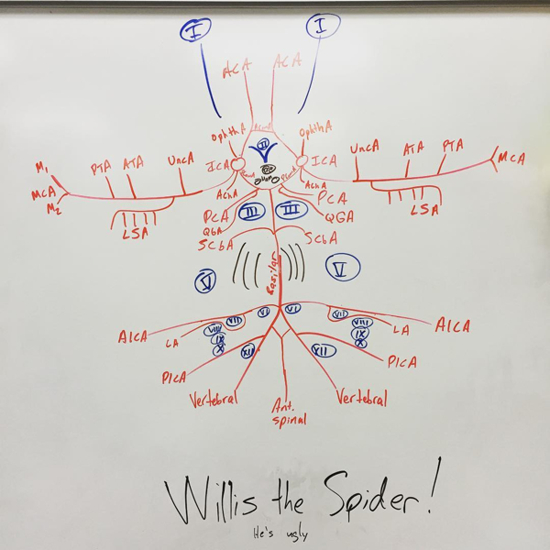 Willis the Spider. (Credit for the schematic design of this picture goes to Clinical Neuroanatomy Made Ridiculously Simple.) These are the arteries that arise at the base of the brain, as well as the cranial nerves (in blue) around which the arteries travel. The arteries are branches of two larger vessel systems: the internal carotid arteries (ICA, Willis' "eyes"), and the vertebral arteries (Willis' back "legs"). Willis the Spider is named for the circle of Willis, the arteries that branch immediately off of the internal carotid arteries.
Alex Farris
Willis the Spider. (Credit for the schematic design of this picture goes to Clinical Neuroanatomy Made Ridiculously Simple.) These are the arteries that arise at the base of the brain, as well as the cranial nerves (in blue) around which the arteries travel. The arteries are branches of two larger vessel systems: the internal carotid arteries (ICA, Willis' "eyes"), and the vertebral arteries (Willis' back "legs"). Willis the Spider is named for the circle of Willis, the arteries that branch immediately off of the internal carotid arteries.
Alex Farris
![The development of the heart and blood circulation in a fetus. I drew the bare-bones (bare-vessels?) diagram and made the list to better understand congenital heart defects. Each step on the left lists what\'s being made (e.g. atrioventricular septum, valves, the twisting wall between the pulmonary artery and the aorta) or what\'s being removed (ductus arteriosus). [The steps are not listed in chronological order. When I drew this, I focused more on easy memorability than exact chronology.] On the right are the ways in which fetal circulation bypasses the liver and lungs, allowing fresh maternal blood to go straight to the fetus\' body.](../Graphics/helloworld05.JPG) Development of the heart and blood circulation in a fetus. I drew the bare-bones (bare-vessels?) diagram and made the list to better understand congenital heart defects. Each step on the left lists what's being made (atrioventricular septum, valves, the twisting wall between the pulmonary artery and the aorta) or what's being removed (ductus arteriosus). [Steps are not in chronological order; I focused more on easy memorability than exact chronology.] On the right are ways in which fetal circulation bypasses the liver & lungs, allowing fresh maternal blood to go straight to the fetus' body.
Alex Farris
Development of the heart and blood circulation in a fetus. I drew the bare-bones (bare-vessels?) diagram and made the list to better understand congenital heart defects. Each step on the left lists what's being made (atrioventricular septum, valves, the twisting wall between the pulmonary artery and the aorta) or what's being removed (ductus arteriosus). [Steps are not in chronological order; I focused more on easy memorability than exact chronology.] On the right are ways in which fetal circulation bypasses the liver & lungs, allowing fresh maternal blood to go straight to the fetus' body.
Alex Farris
 The metabolism of hemoglobin (and then some). This is a long and winding road involving vitamin B12, an iron-binding protein called ferritin, and chromosomes 11 and 16. I combined multiple individual pathways that wouldn't seem to go together, such as the metabolism of methylmalonic acid and the fate of bilirubin. It seems I was in a synthetic mood on January 22.
Alex Farris
The metabolism of hemoglobin (and then some). This is a long and winding road involving vitamin B12, an iron-binding protein called ferritin, and chromosomes 11 and 16. I combined multiple individual pathways that wouldn't seem to go together, such as the metabolism of methylmalonic acid and the fate of bilirubin. It seems I was in a synthetic mood on January 22.
Alex Farris
 Insulin release from pancreatic beta cells in response to glucose. The GLUT2 receptor brings a molecule of glucose into the cell, and its potential energy helps create more of the energy currency of the cell, ATP. This results in a higher ratio of ATP to its lower-energy waste product, ADP, signalling that the cell has enough energy. The higher ATP/ADP ratio prevents potassium ions (K+) from leaving the cell, and the resulting positive charge (i.e. depolarization) opens a channel for calcium ions (Ca2+). The calcium ions interact with myosin in a form similar to the elegant dance that makes muscles contract, and eventually insulin is released from preformed granules to the outside of the cell. Insulin, of course, signals to other cells that there's enough glucose in the blood, causing those cells to absorb glucose. / A class of diabetes drugs, the sulfonylureas, binds to the potassium ion channel, causing insulin to be released.
Alex Farris
Insulin release from pancreatic beta cells in response to glucose. The GLUT2 receptor brings a molecule of glucose into the cell, and its potential energy helps create more of the energy currency of the cell, ATP. This results in a higher ratio of ATP to its lower-energy waste product, ADP, signalling that the cell has enough energy. The higher ATP/ADP ratio prevents potassium ions (K+) from leaving the cell, and the resulting positive charge (i.e. depolarization) opens a channel for calcium ions (Ca2+). The calcium ions interact with myosin in a form similar to the elegant dance that makes muscles contract, and eventually insulin is released from preformed granules to the outside of the cell. Insulin, of course, signals to other cells that there's enough glucose in the blood, causing those cells to absorb glucose. / A class of diabetes drugs, the sulfonylureas, binds to the potassium ion channel, causing insulin to be released.
Alex Farris
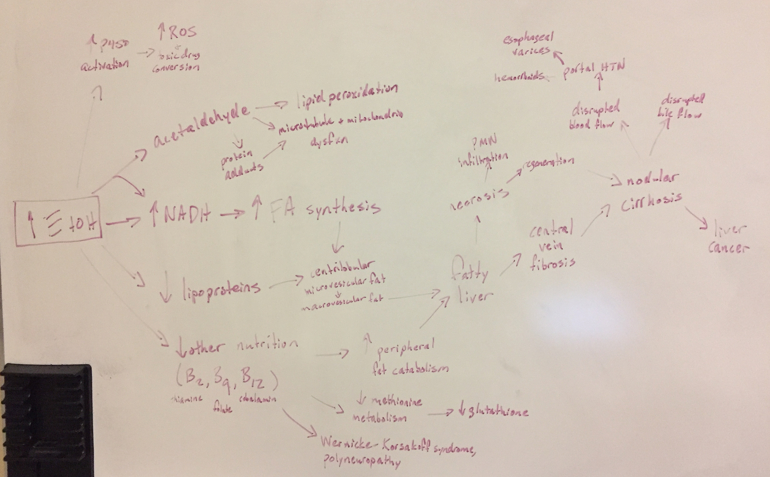 Effects of alcohol (EtOH) on various physiological processes. We all know the short-term psychological effects of alcohol: the inhibition, the loss of concentration, the eventual incoherence. As shown in this convoluted map, long-term overconsumption affects more than just behavior. Each branch of this map is worth following.
Alex Farris
Effects of alcohol (EtOH) on various physiological processes. We all know the short-term psychological effects of alcohol: the inhibition, the loss of concentration, the eventual incoherence. As shown in this convoluted map, long-term overconsumption affects more than just behavior. Each branch of this map is worth following.
Alex Farris
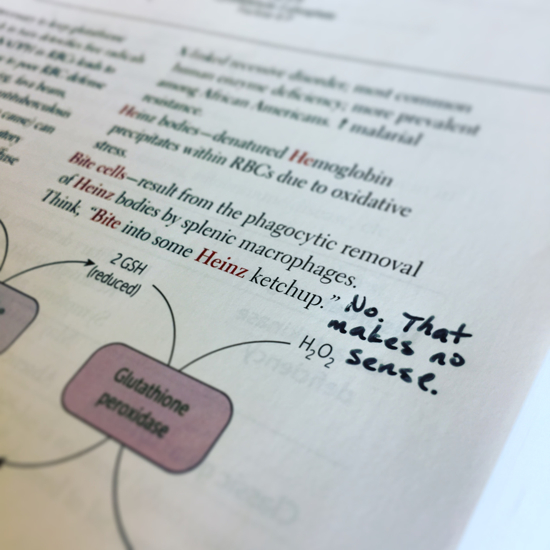 A bad, but effective, memory hook. For medical students taking their first board exam, First Aid for the USMLE Step 1 is absolutely essential. It presents every fact & theory needed for the exam as memorably as possible. This results in some groan-worthy mnemonics. Bite cells refer to red blood cells with a piece bitten off them by white blood cells in the spleen; they specifically remove Heinz bodies, collections of hemoglobin that build up after prolonged stress. Thus, "Bite into some Heinz ketchup." It's such a maddeningly bad sentence that it wraps around the spectrum and becomes helpful.
Alex Farris
A bad, but effective, memory hook. For medical students taking their first board exam, First Aid for the USMLE Step 1 is absolutely essential. It presents every fact & theory needed for the exam as memorably as possible. This results in some groan-worthy mnemonics. Bite cells refer to red blood cells with a piece bitten off them by white blood cells in the spleen; they specifically remove Heinz bodies, collections of hemoglobin that build up after prolonged stress. Thus, "Bite into some Heinz ketchup." It's such a maddeningly bad sentence that it wraps around the spectrum and becomes helpful.
Alex Farris
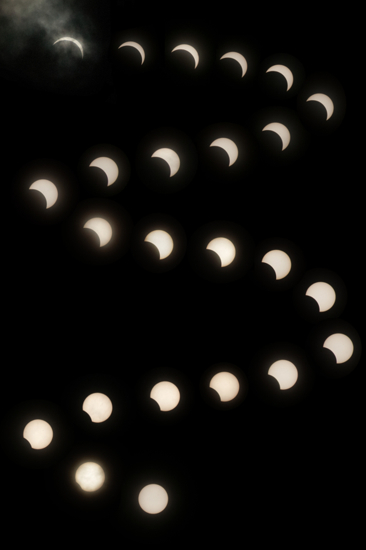 Somehow, I found time over the past two years to take other pictures. As I mentioned in a 2014 blog post, I had been looking forward to this year's solar eclipse for a long time. I first put it on my Google calendar in 2009, and I envisioned being in Hopkinsville, Ky., for totality. My third-year clerkships made that trip impossible, but I could still see a great partial eclipse. So, during online lectures, I put a filter on my camera and set it to take a picture every minute. Cloud cover obscured the first half of the action, but the sky parted just before the point of maximum eclipse for Lafayette.
Alex Farris
Somehow, I found time over the past two years to take other pictures. As I mentioned in a 2014 blog post, I had been looking forward to this year's solar eclipse for a long time. I first put it on my Google calendar in 2009, and I envisioned being in Hopkinsville, Ky., for totality. My third-year clerkships made that trip impossible, but I could still see a great partial eclipse. So, during online lectures, I put a filter on my camera and set it to take a picture every minute. Cloud cover obscured the first half of the action, but the sky parted just before the point of maximum eclipse for Lafayette.
Alex Farris
